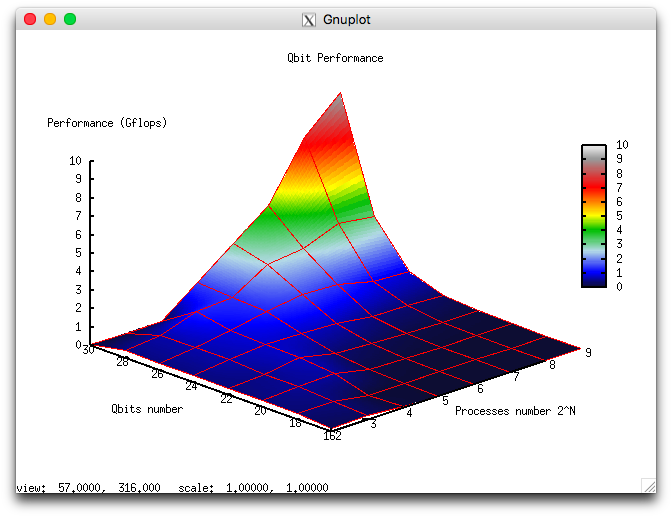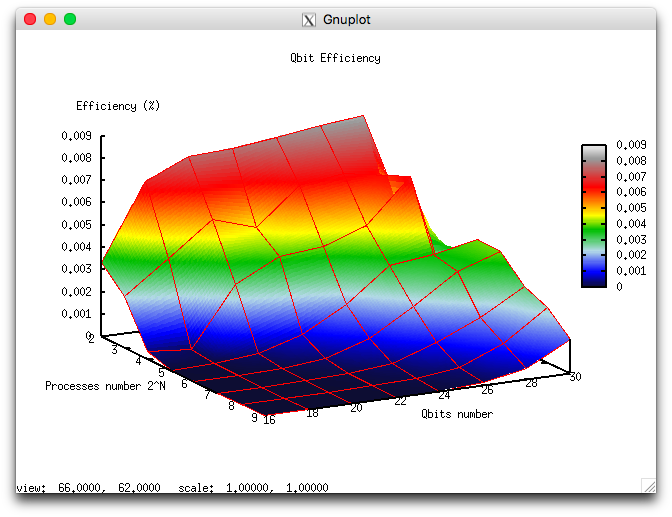Single-qubit transform of a state vector, scalability
Contents
1 Links
The implementation of the algorithm used for the analysis is available here.
2 Locality of data and computations
2.1 Locality of implementation
2.1.1 Structure of memory access and a qualitative estimation of locality
2.1.2 Quantitative estimation of locality
3 Scalability of the algorithm and its implementations
3.1 Scalability of the algorithm
Because of the constant height of the parallel form the algorithm is very good scalable for the shared memory implementation. But the usage of the distributed memory leads to the locality problems.
3.2 Scalability of of the algorithm implementation
Let us perform a scalability analysis of a particular implementation of the single-qubit transform algorithm according to the scalability methodology with the use of the Lomonosov supercomputer[1] installed at the Research Computing Center of Moscow State University.
- the number of processors [4 : 512] with the powers of 2 step;
- the number of qubits [16 : 32] with step 2.
- minimum 0.000003%;
- maximum 0.008%.
The following Figures illustrate the performance and efficiency of the chosen parallel implementation of the Cholesky algorithm, depending on the startup parameters.
for the efficiency are shown at Figure 2b. It can be seen, that efficiency is quite low, but it grows fast with the number of qubits and remains constant with simultaneous increasing of the number of processors and qubits.
4 Dynamic characteristics and efficiency of the algorithm implementation
All results were obtained on the "GraphIT!" supercomputer. For the experiments we used the Intel Xeon X5570 processors with 94 Gflops peak performance and the Gnu 4.4.7 compiler.
The CPU usage diagram shows that the average CPU usage during almost all the runtime of the program is about 50%. This fact shows high load, when 8 processes works on 8 processors without HyperThreading technology. It means, that the usage of all physical cores is near to 100%.
Diagram for the number of floating point operations per second shows high performane. The peak performance is 300 mln. flops, and about 70 mln. flops on average between nodes. This fact may indicate the disbalance of the computations with rather high performance.
The diagram for the number of L1 cache-misses shows a high number of misses (4 mln/sec for some processe and 1 mln/sec on average). It indicates the high intensity and locality, and the disbalance of computations among processors.
The diagram for the number of L3 cache-misses still shows rather high number of misses (1 mln/sec at the peek and 0.25 mln/sec on average). The of L1/L3 misses is about 4 and it is average for the class of the same tasks. This value also shows low locality of computations.
The diagram for the number of memory read operations shows low activity of memory reads. Because of the big number of working processes, the difference between peak and average value of the activity shows the computations are unbalanced. The activity is lower than for typical software of the same class.
The activity of write operations is low, as it can be expected.
The plot of the number of processes ready for the execution (LoadAvg) shows that this value remains constant and approximately equals 3 throughout the program run. This shows that the program is operating in a stable manner, with small number of processes on each node. It confirms the suggestion about the disbalance of computations and shows that some processes have low activity.
Overall, the data obtained from the monitoring system allows one to come to the conclusion that the program under study works with low efficiency, but with the load disbalance. So, the program can be possibly optimized by the improvement of the processors balance.
5 Run results
6 References
- ↑ Voevodin Vl.V., Zhumatii S.A., Sobolev S.I., Antonov A.S., Bryzgalov P.A., Nikitenko D.A., Stefanov K.S., Voevodin Vad.V. The Lomonosov supercomputer in practice. Otkrytye Sistemy (2012) No. 7, 36-39.








